No-nonsense performance all wrapped up in austere aesthetics and sublime simplicity.
Following the long tradition of alphabet soup naming conventions for personal audio equipment, comes a newcomer to the scene: the Soncoz LA-QXD1 DAC. (Doesn’t the name just flow from the tongue like poetry?) It’s the little brother to the Soncoz SGD1 DAC.
Both of these new products are the brainchild of Ben1987 (as he’s called on the Audio Science Review forums) who is best known as the designer of the much-lauded Kahdas Tone Board DAC. The Tone Board is a very basic DAC with fantastic performance and a rock bottom price. I used and discussed it in my NuHybrid build article.
“The Kahdas Tone Board is an odd duck; it is entirely without a case, as it was originally intended to be inserted directly on top of a tiny computer board. However, due to the outstanding sound quality measurement results, it has been quickly gathering popularity in the DIY community…
I have found the Tone Board to live up to its reputation. It looks, feels, and sounds excellent; far beyond its modest (approximately) $100 price tag.” – From my Nuhybrid article.
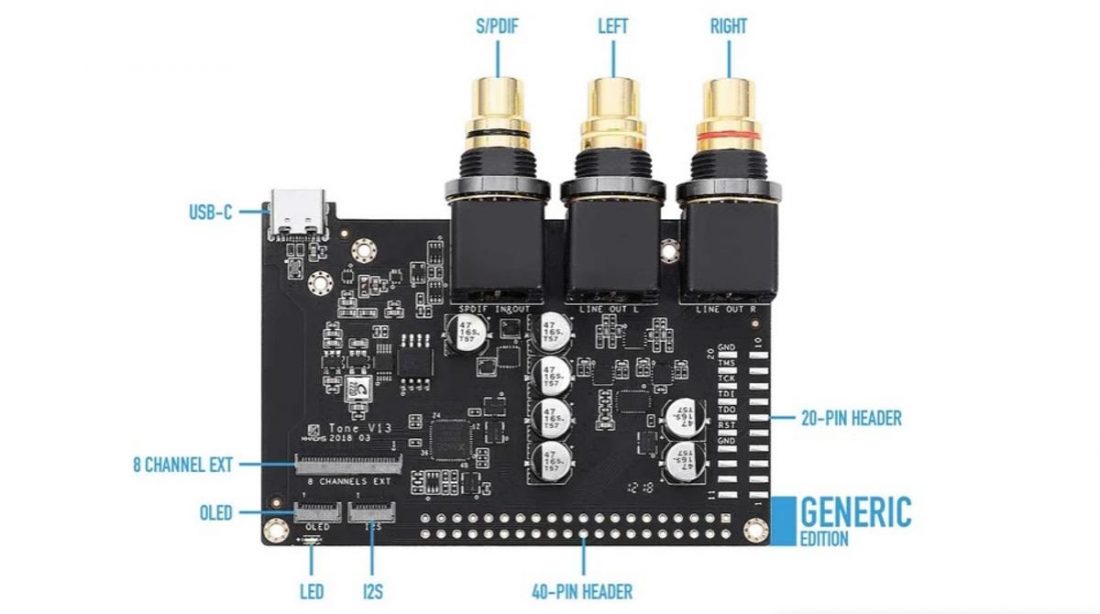
Both Soncoz products are a direct evolution from the Tone Board. In fact, all three share the same ES9038Q2M DAC chip. However, rather than a no-frills DIY product, the Soncoz DACs are housed in beautifully finished aluminum enclosures and feature a number of additional features and improvements.
With the basic ($99) Khadas Tone Board anchoring the bottom end, the LA-QXD1 is a solid upgrade (priced at $199) and is in between the ($459) SGD1. Both the Soncoz units feature balanced and single-ended analog outputs, as well as optical, coaxial, and USB inputs, and hardware volume controls. The SGD1 also includes a front panel display, remote control, Bluetooth 5.0, and additional inputs.
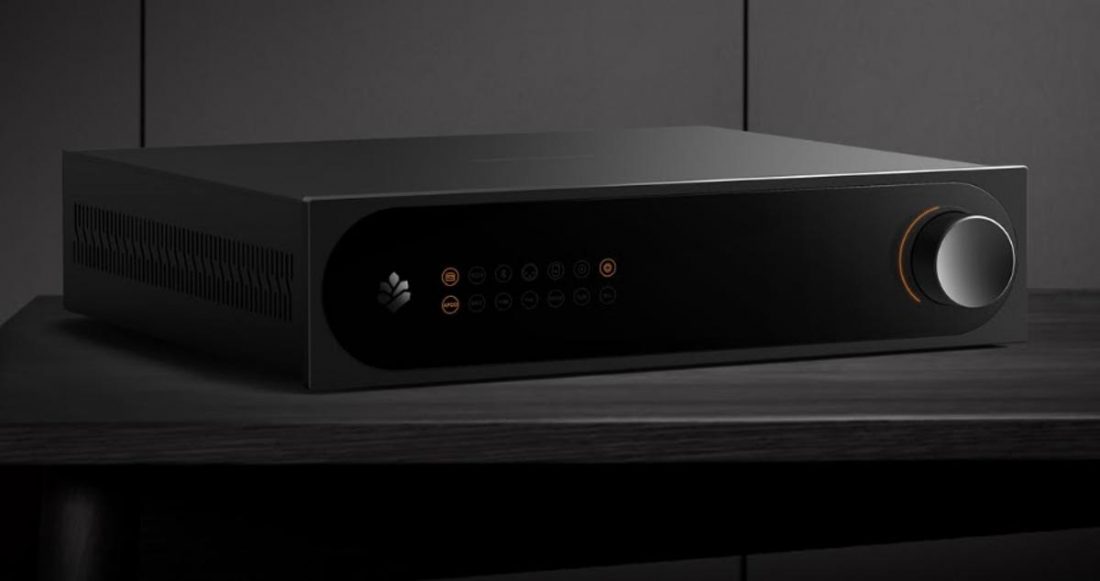
So, did Ben take what he learned from designing the Tone Board and hit a home run with his first solo products? Did he create a real competitor to the well-respected, and currently very popular, budget DAC offerings from SMSL and Topping?
Does it live up to Soncoz’s modest claim of “LA-QXD1: A NICE FULLY-BALANCED DAC”?
Let’s find out.
- Solid and heavy construction is impeccably finished.
- Balanced outputs.
- Outstanding measurements.
- The sound is transparent and uncolored.
- Very good format support.
- Excellent bang for the buck.
- The designer is an active participant in enthusiast forums and releases new firmware changes based on member input.
- No front screen or indicators to determine current settings or verify bitrate etc.
- No power switch nor auto-standby feature so it’s always on if plugged in.
- The small, unobtrusive and plain design may not appeal to everyone.
- No power supply included.
- Online only instruction manual.
- The audio filters are a subtle mystery.
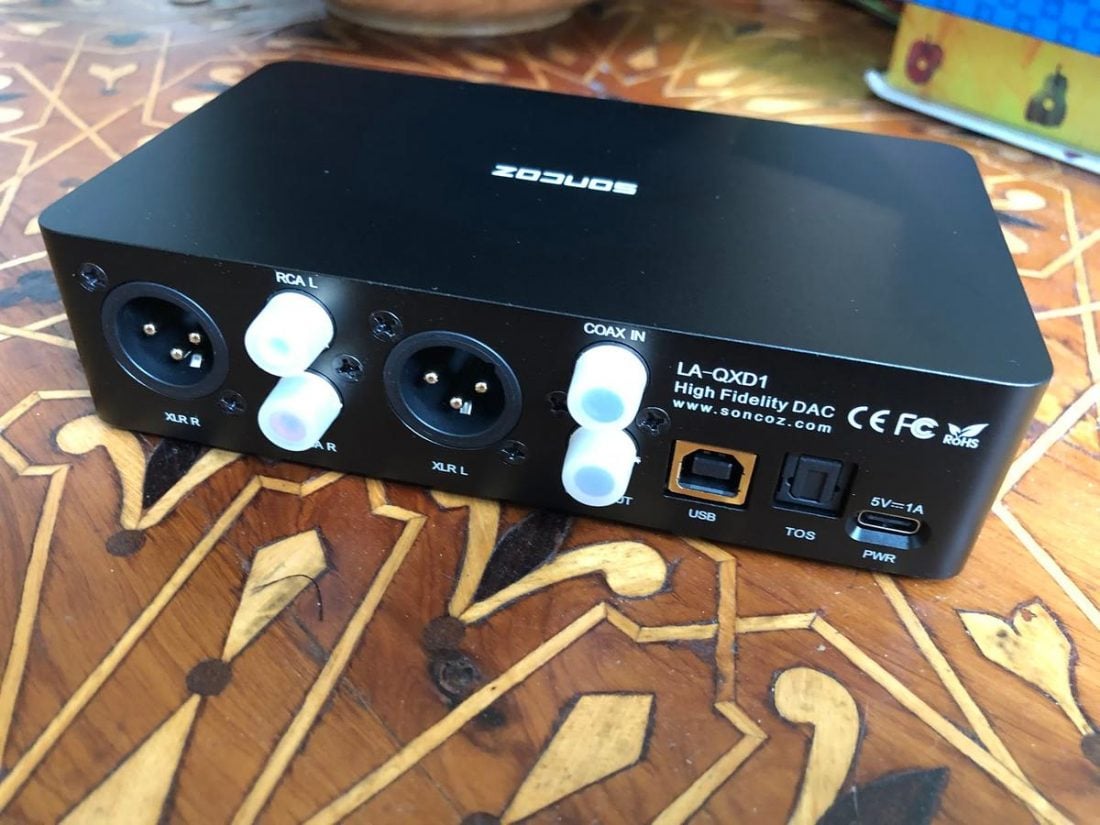
Soncoz LA-QXD1 Technical Specifications
- Dimensions: 149.3 mm(W) 87 mm(D) 37 mm(H)
- Weight: 500 g
- Colour: Deep Black / Space Gray
- Power Input: DC 5 V @ 1 A
- Power Consumption: < 4 W
- Signal Input: USB-B / Toslink / RCA Coaxial
- Digital output: RCA Coaxial
- Line out: XLR / RCA
- Frequency Response: 20Hz-20KHz XLR / RCA (±0.18 dB)
- Dynamic range (DNR): A-W XLR > 122 dB; RCA > 122dB
- Signal noise ratio (SNR): A-W XLR > 121 dB; RCA > 121 dB
- THD+N: 1 kHz XLR / RCA < 0.00014% (-117 dB)
- Crosstalk: 1 kHz XLR > 133 dB; RCA > 130 dB
- Output voltage: XLR 4.0 V; RCA 2.0 V
- Output impedance: XLR 200 Ω ; RCA 100 Ω
- Noise floor modulation: 4.3 μV rms
Rear Panel
- XLR output: 4.0Vrms@0dBFS
- RCA output: 2.0Vrms@0dBFS
- Coaxial input: 24-bit/192kHz
- Coaxial output: 24-bit/192kHz
- USB-B input: 32-bit/768kHz PCM/DSD 512(Native)
- Optical input: 24-bit/192kHz
- Power input: USB-C 5V 1A
Front Panel
- Optical input indicator (OPT)
- Coaxial input indicator (COAX)
- USB-B input indicator
- Mute (Flash) indicator
- Audio inputs switching button (Mode)
- Volume down button
- Volume up button
- Mute button
Soncoz LA-QXD1 Packaging
The packaging and unboxing experience with the LA-QXD1 was quite good. The DAC arrived at my door in a plain cardboard 5x8x3.5 inch box with Soncoz branded tape securing it. Inside, the unit was nestled securely in a plain (but classy) white box with the “Soncoz – The Power of Original Sound” logo embossed on the top and the unit’s specifications printed on the bottom.
The two USB cables were found in a cut out in the foam under the LA-QXD1.
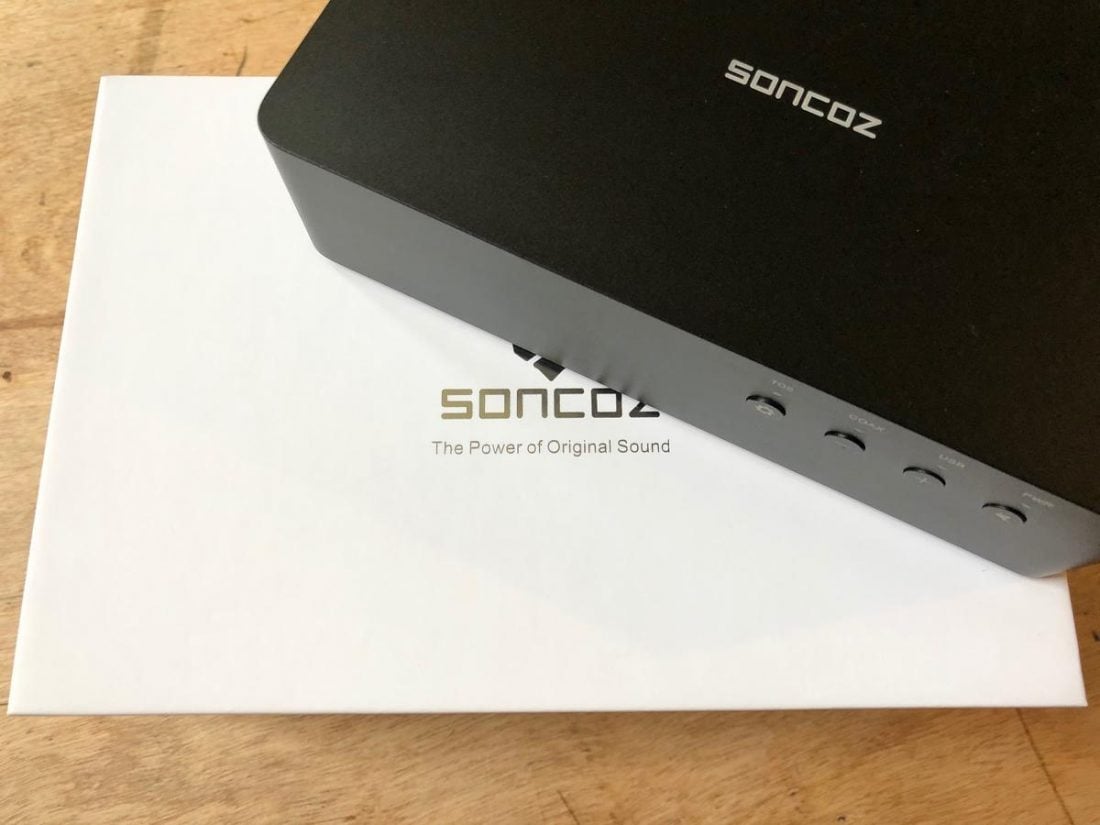
In the Box
- The LA-QXD1 DAC unit.
- 1.5m USB A-B data cable.
- 1.5m USB C power cable.
- Soncoz decal.
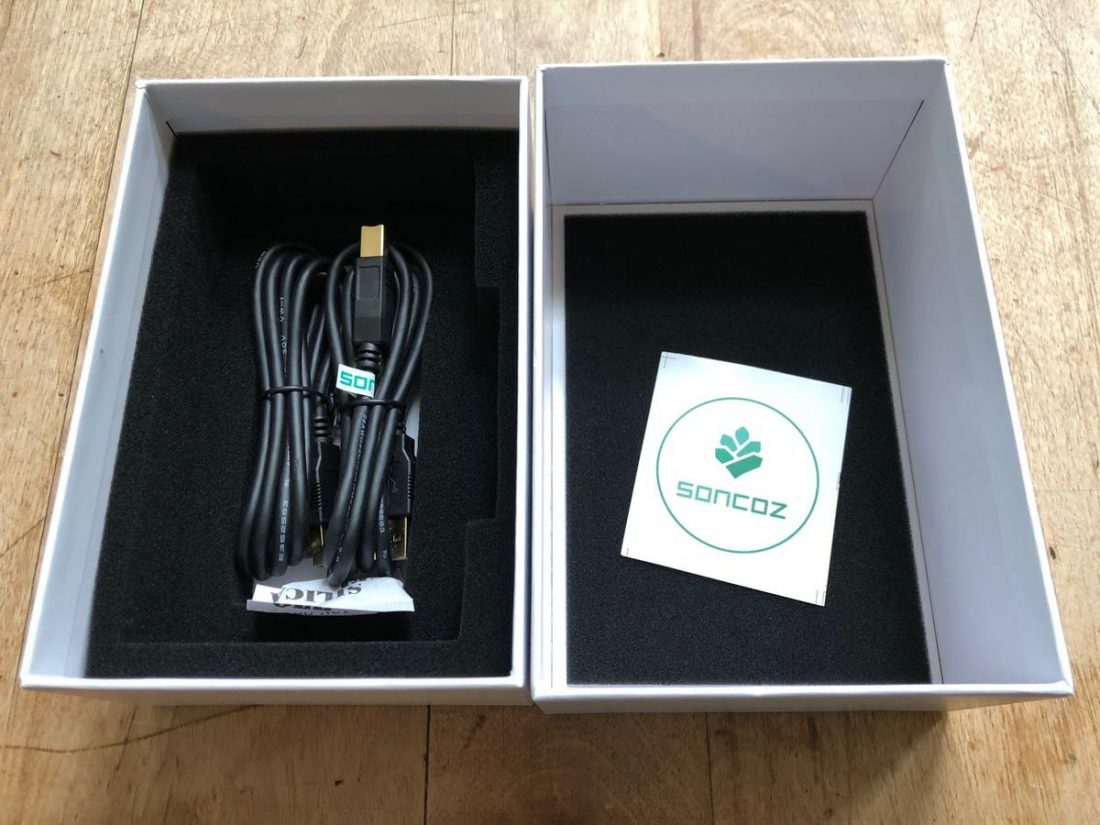
Soncoz LA-QXD1 Design
Housed in slightly more than 1 pound of solid, CNC machined, anodized aluminum, the LA-QXD1 feels really great. The solid, weighty presence and rubber feet are a real benefit for a unit this small and for one that is likely to have many large interconnects plugged in the back. For the most part, it stays put and doesn’t move around when you push the front-mounted buttons.
On paper, the LA-QXD1 does what a good DAC should. It features wide format support (up to 32-bit/768kHz PCM, and native DSD 512), lots of digital inputs (coaxial, optical Toslink, and USB), balanced XLR and single-ended RCA analog outputs (Ben doesn’t recommend using both simultaneously), and a coaxial digital output. It also has 7 user-selectable audio filters.
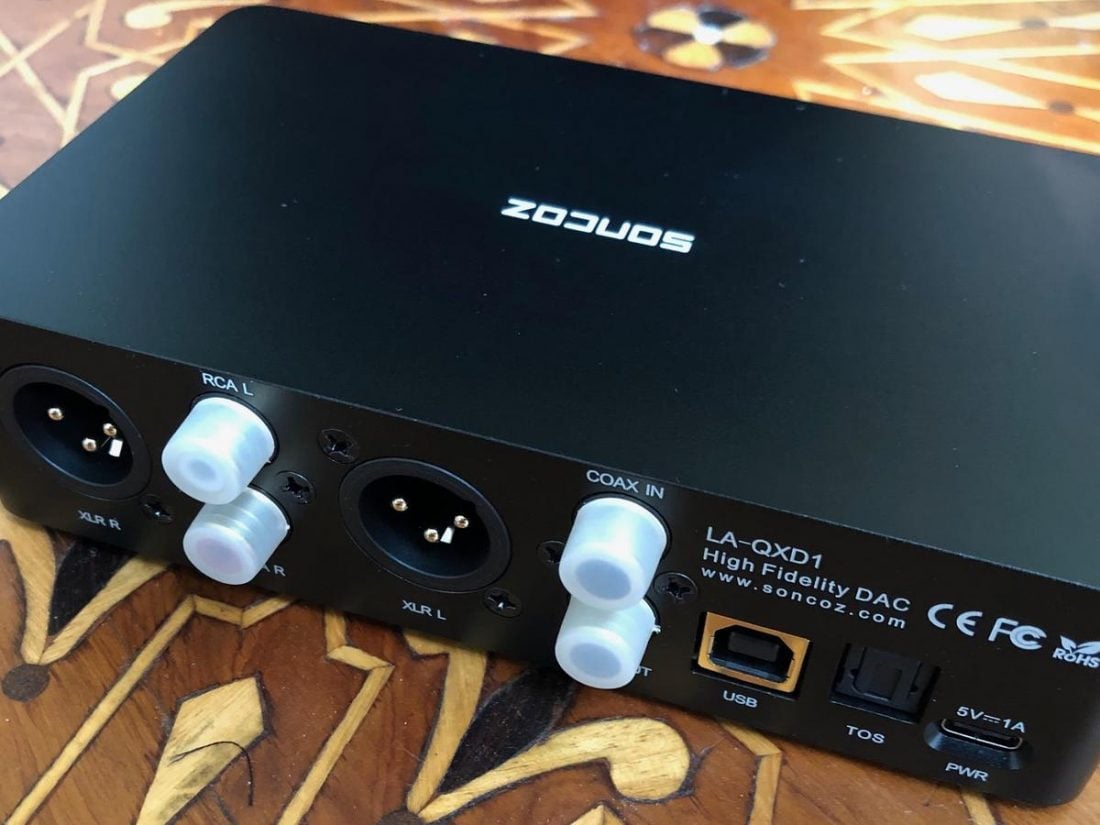
It should be noted that with the inclusion of a coaxial output, the LA-QXD1 can serve as a digital converter, transforming the other digital inputs into coaxial digital output.
The front panel is very minimalist with four buttons (Mode, –, +, Mute) and four tiny amber LEDs (labeled TOS, COAX, USB, PWR) above the buttons. The PWR (power) indicator is a bit misleading on the LA-QXD1 as there is no standby or power-off mode (nor switch). As long as the unit is plugged into a 5V 1A USB power source, it remains active with the LED illuminated.
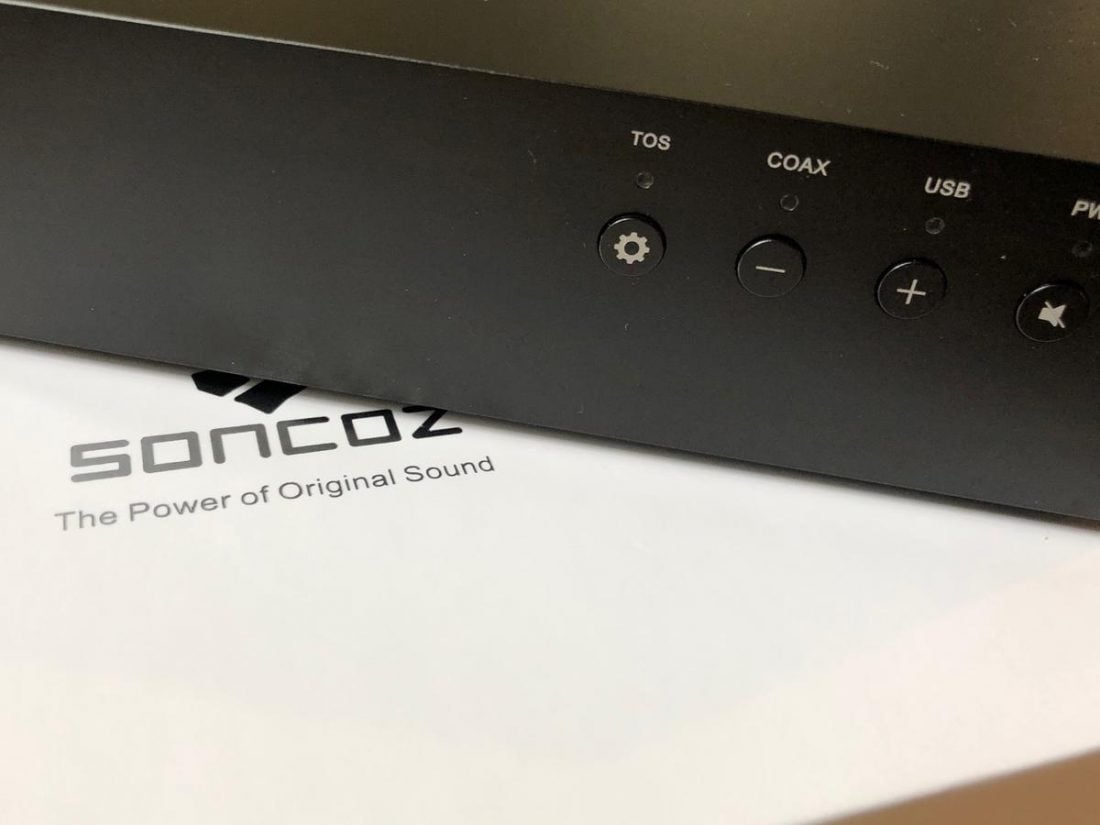
Soncoz LA-QXD1 Interface
The buttons are the tiny, momentary ‘clicky’ type and while they work fine, they simply don’t have a premium feel. It helps to activate them with your thumb while resting your fingers on top of the unit, making the LA-QXD1 fairly secure and unlikely to slide back.
While Soncoz claims that the indicator LEDs “clearly indicate the current working status of the unit”, and that the “operation logic is simple and very easy to get started”, in practice, it’s not all quite as simple as it should be.
Soncoz LA-QXD1 Audio Filters
The process to select and change between the 7 audio filters is not intuitive.
Hold the Mute button for more than 2 seconds and the DAC will cycle through the filters each time you (long) press the button. Corresponding LEDs will flash (single or combined) to indicate which filter is selected. To save and exit the selection process, quickly press the Mode button (which is also used to select the digital input).
Note that the filter LED combinations are in no way labeled on the unit. In fact, they aren’t even explained in the manual! Both the LA-QXD1 and the bigger brother SGD1 DAC share the same filters, and while it is possible to summarize them, the exact function of each filter is inexplicably not documented.
LA-QXD1 Filter Modes
| Filter Name | Description | LED 1 (Mode) | LED 2 (Vol -) | LED 3 (Vol +) |
|---|---|---|---|---|
| APOD | Apodizing fast roll-off filter | ON | ||
| BRIC | Brick wall filter | ON | ||
| FAM | Minimum phase fast roll-off filter | ON | ON | |
| FAL | Linear phase fast roll-off filter | ON | ||
| HYER | Hybrid fast roll-off filter | ON | ON | |
| SLM | Minimum phase slow roll-off filter | ON | ON | |
| SLL | Linear phase slow roll-off filter | ON | ON | ON |
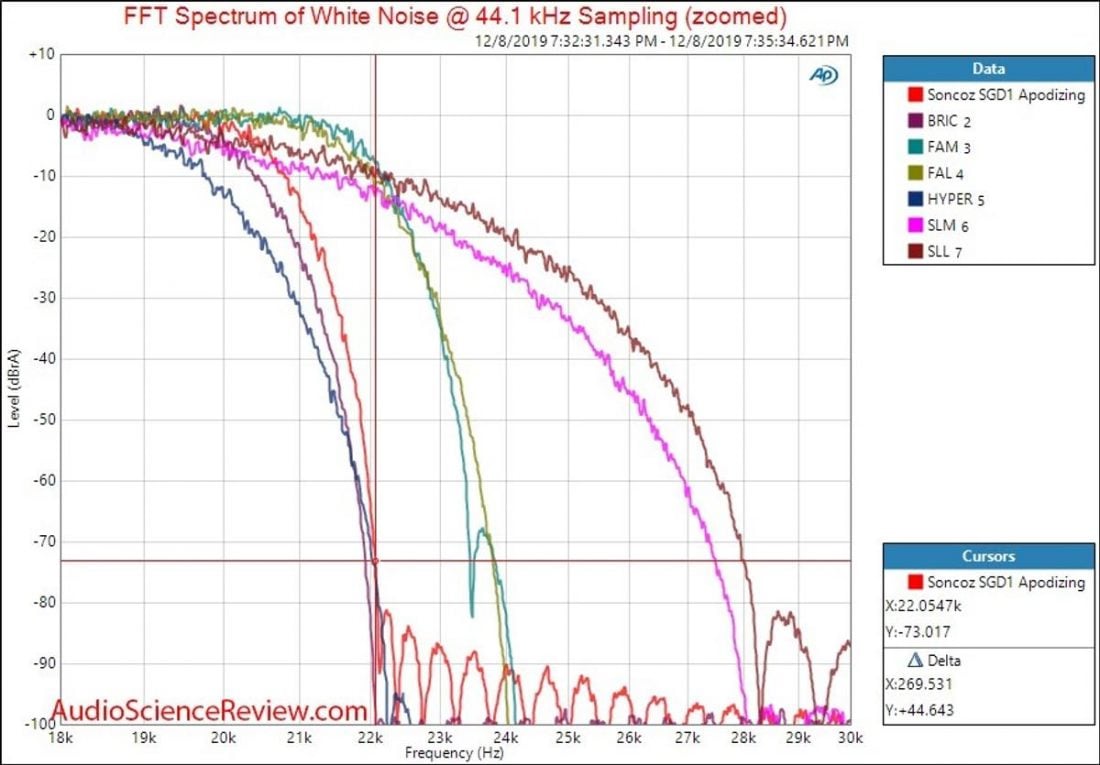
What I wouldn’t give for a couple more rows of tiny indicator LEDs on this DAC?!?
I don’t think it needs a full-featured OLED screen, but it would be excellent to have a bit more information about what is going on. Current file format, bit rate and filters could be indicated just like the digital inputs, with a discrete row of tiny unobtrusive LEDs and clean labels.
Soncoz LA-QXD1 Internals
All DACs are not created equal, even those that share the very same D/A converter chip. The chip is not the only thing that matters in audio reproduction quality. The choice and implementation of all the internal components play a role in how the device works and sounds.
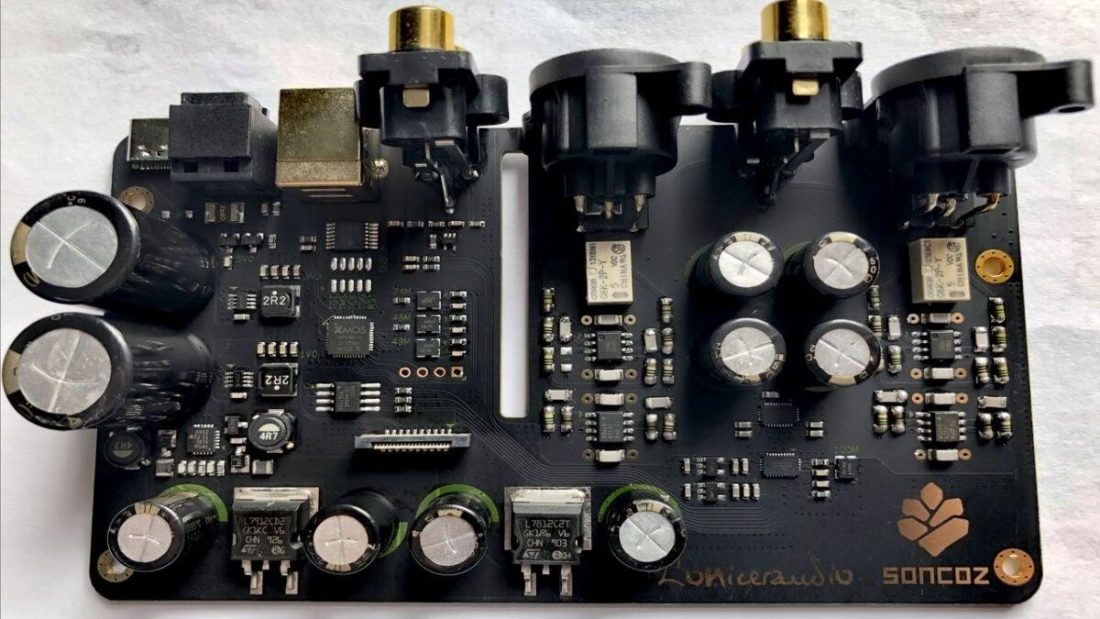
The heart of these Soncoz DACs is the ESS ES9038Q2M SABRE reference DAC chip. It is designed to be a high-performance, 32-bit, stereo audio D/A converter intended for audiophile-grade portable applications (such as mobile phones, digital music players, etc.). It’s a marvel of technology.
It also has shown to have a flaw in implementation.
The Infamous ESS IMD Hump
Let’s address the technical elephant in the room (or perhaps I should call it a camel since it’s known for having a hump) but either way it is a well-documented issue with particular ESS DAC chips (like the ES9038Q2M used in the LA-QXD1).
The ESS hump is typically defined as a significant increase in Total Harmonic Distortion (THD) in Intermodulation Distortion (IMD) measurements. Without getting too bogged down in the technical minutia, graphs of properly working chips should show a straight diagonal line (or in other words: linear) performance measurement. The ESS chips tend to have a large bulge (or ‘hump’) in the line.
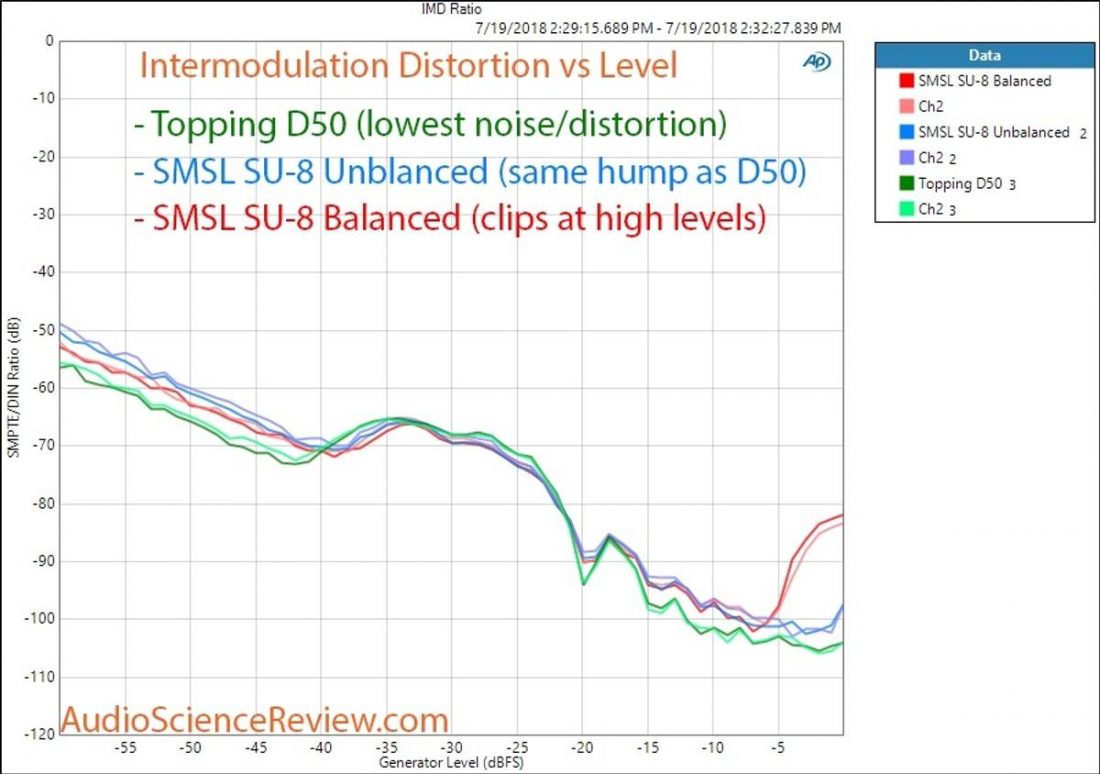
Well, it turns out that Ben was part of the team that publicly presented a fix. He found that by adjusting the combination of resistance and capacitance values in the circuit could fix the hump problem. And could be implemented without any sacrifice to performance.
So, rest assured that both Soncoz DACs have implemented this fix (released in Q4 2019) and we can all put the ESS IMD hump behind us.
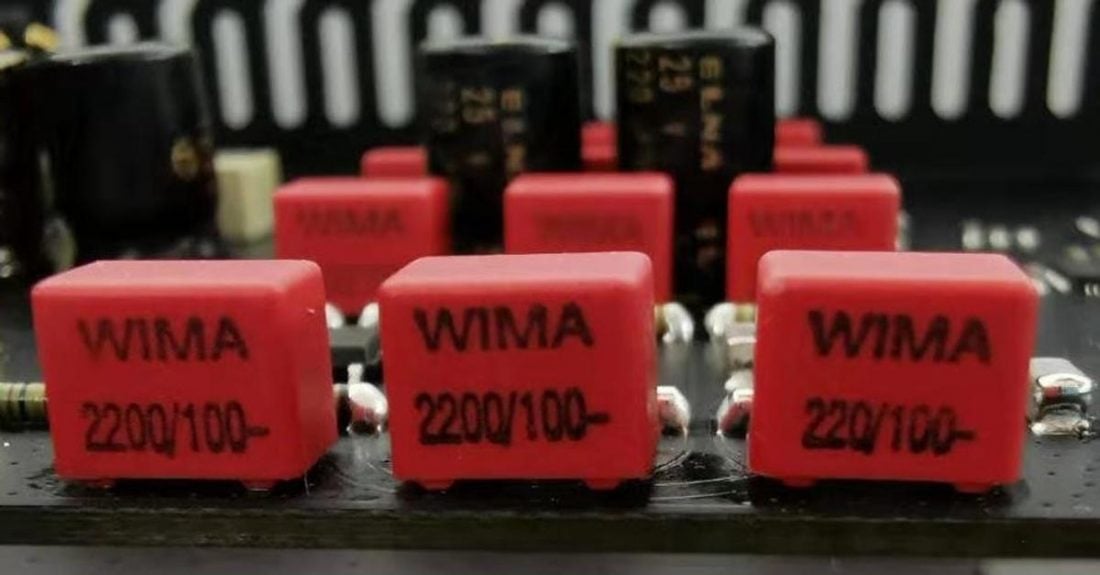
Soncoz LA-QXD1 Updates
Ben is a very active participant in online audio forums. He appears to genuinely welcome user feedback and tries to fix any problems or requests that come up. Part of this is done through the firmware updates that he provides.
As of the time of writing, the most up to date (2020-07-10) firmware updates can be downloaded from HERE. After unzipping, you’ll find two files“LA-QXD1 Maximum Volume with Hardware Control DFU_V410.bin” and “LA-QXD1 Minimum Volume DFU_V401.bin”.
The V401 Minimum Volume firmware is how the device is shipped. The unit defaults to -64 dB volume level upon powering up and the volume must be manually increased (via the front + button) to 0 dB (maximum volume) to use the DAC as a standard line-out device. Ths default setting allows the device to be used as a preamp volume control for devices like powered speakers.
For those that prefer to use the LA-QXD1 as a standard line output DAC, the V410 Maximum Volume with Hardware Control firmware can be flashed using the included tool. This changes the device to default to the maximum 0 dB volume upon power on.
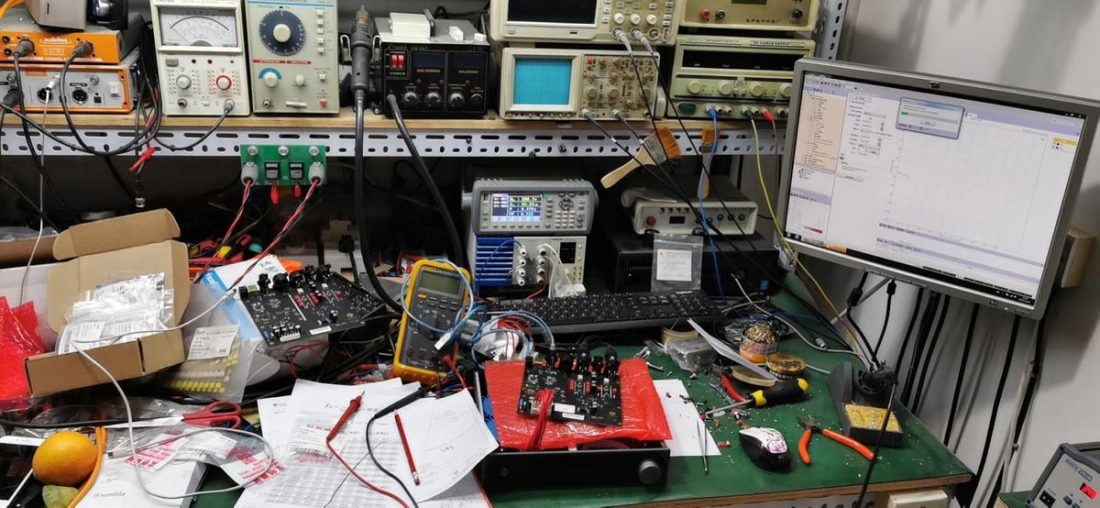
Soncoz LA-QXD1 Sound Quality, Measurements and Performance
The LA-QXD1 has quickly become a darling of the measurement community. Most notably on the Audio Science Review forums. ASR provides an extremely comprehensive set of results for many DACs. Their measurements of the LA-QXD1 can be summarized as:

The LA-QXD1 is truly in the top tier of measured DACs, regardless of price. The results show a measured SINAD of 115 dB+ and 120 dB of dynamic range. The scientific-focused goal of a good DAC is to be audibly transparent and the LA-QXD1 seems to achieve this.
I find it difficult to bring a subjective perspective beyond that conclusion. At no times did I find I was ‘hearing the DAC’, nor did I find any significant audible differences between the LA-QXD1 and its lesser sibling, the Tone Board.
It functioned perfectly for me. Connected to my trusty old MacBook Air running Audirvana, the LA-QXD1 effortlessly played any file format I threw at it. No unwanted color, noises, or errors were encountered.
Since I’m very used to the sound of my Tone Board, the LA-QXD1 sounded exactly like what I expect a good DAC to be. Pretty much invisible.
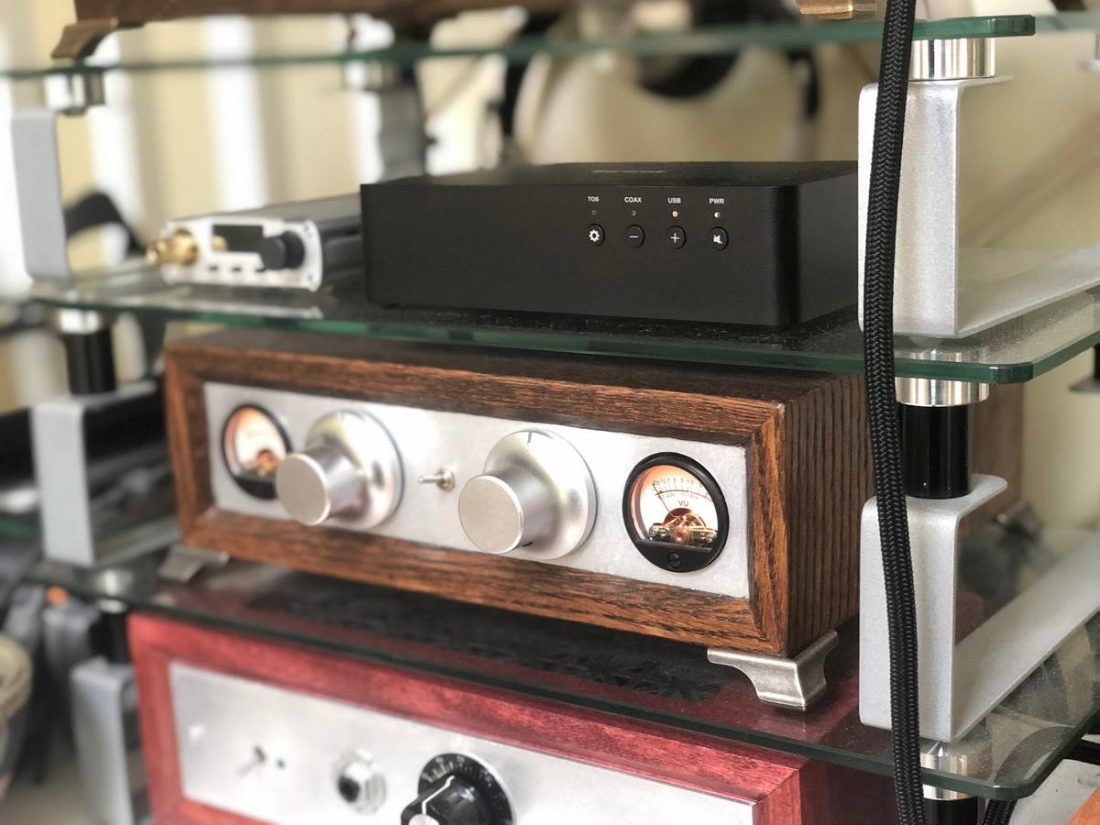
So, how about those filters? Just like other DACs that have walked through my doors, I dutifully played around with the adjustable filter settings. And, in the end, I decided that the differences were oh-so-subtle. Since the filter options didn’t significantly convince me that one was better than the others, I happily just settled for the default filter and moved on to enjoy the music.
Conclusion
First off, a big thank you to the good folks at HIFIGO for sending the LA-QXD1 for review and it is available directly from HIFIGO for $199.
Is the LA-QXD1 the perfect DAC for everyone? Probably not, but it really could be.
If you value a DAC that is ‘set it and forget it’, or a DAC that handles almost any file format, and has top-tier performance measurements, then this one has to be on your short list of contenders.
The LA-QXD1 does all the important things (like making beautiful music), and it does them well. Let’s also not forget it sits firmly in the affordable bang-for-the-buck category.
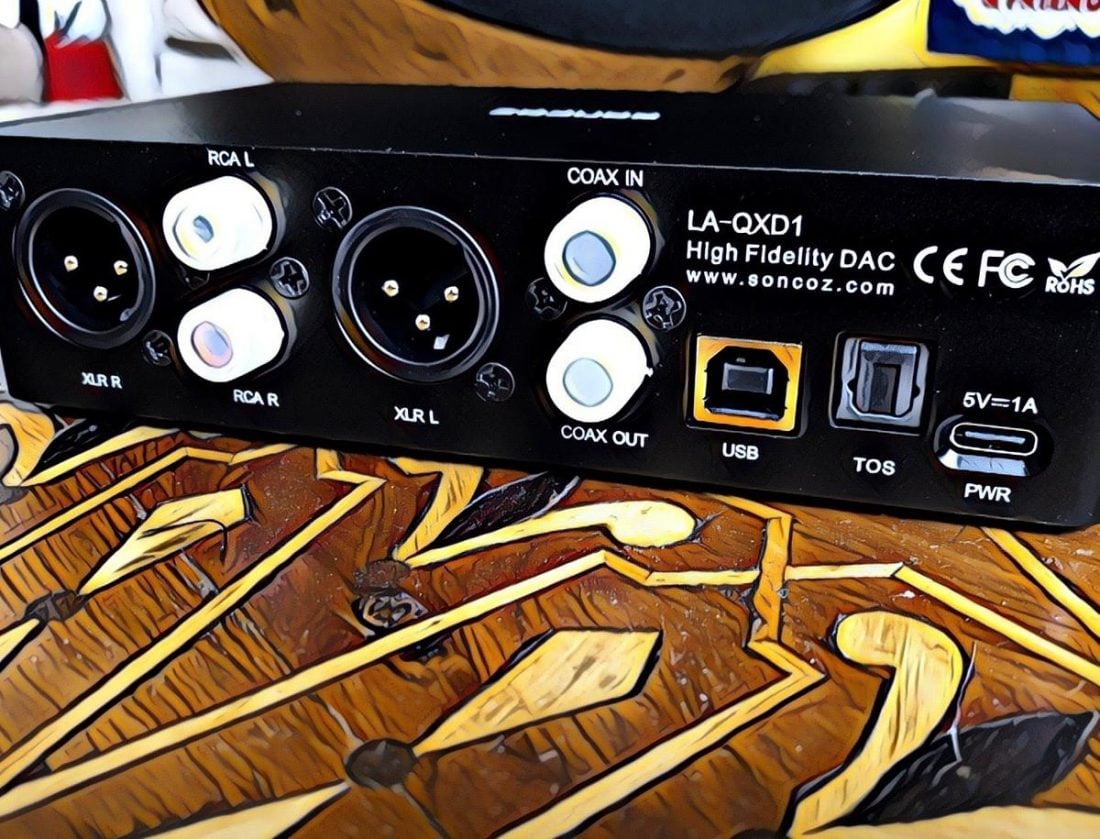
However, I think the average audio enthusiast may want more. Perhaps physical features like a power switch or remote control. Even I can want more, and I’m a guy used to an entirely hidden Khadas Tone Board (although I did add a power LED so I know when it is plugged in).
The biggest omission on the LA-QXD1 is a screen (or a bank of LEDs) to indicate the current status. This is an enthusiast product, and the people who are concerned about 32-bit/768kHz or DSD512 file format support, are likely the same folks who want to confirm that they are getting it.
My main complaint with the navigation and indication of the audio filters is essentially rendered null if you use the DAC as it appears to be intended. Plug it in. Forget about it. Don’t worry about all the other stuff and just trust that it is working.
I have a feeling that one feature may drive more sales of the LA-QXD1 than any other. Balanced XLR outputs. If this feature is important for you, the list of comparatively priced alternatives drops significantly.
So if you can appreciate a device that invisibly ‘just works’, and does its job as well as options costing far more, yet with absolutely no fanfare, the Soncoz LA-QXD1 may just be the DAC for you.
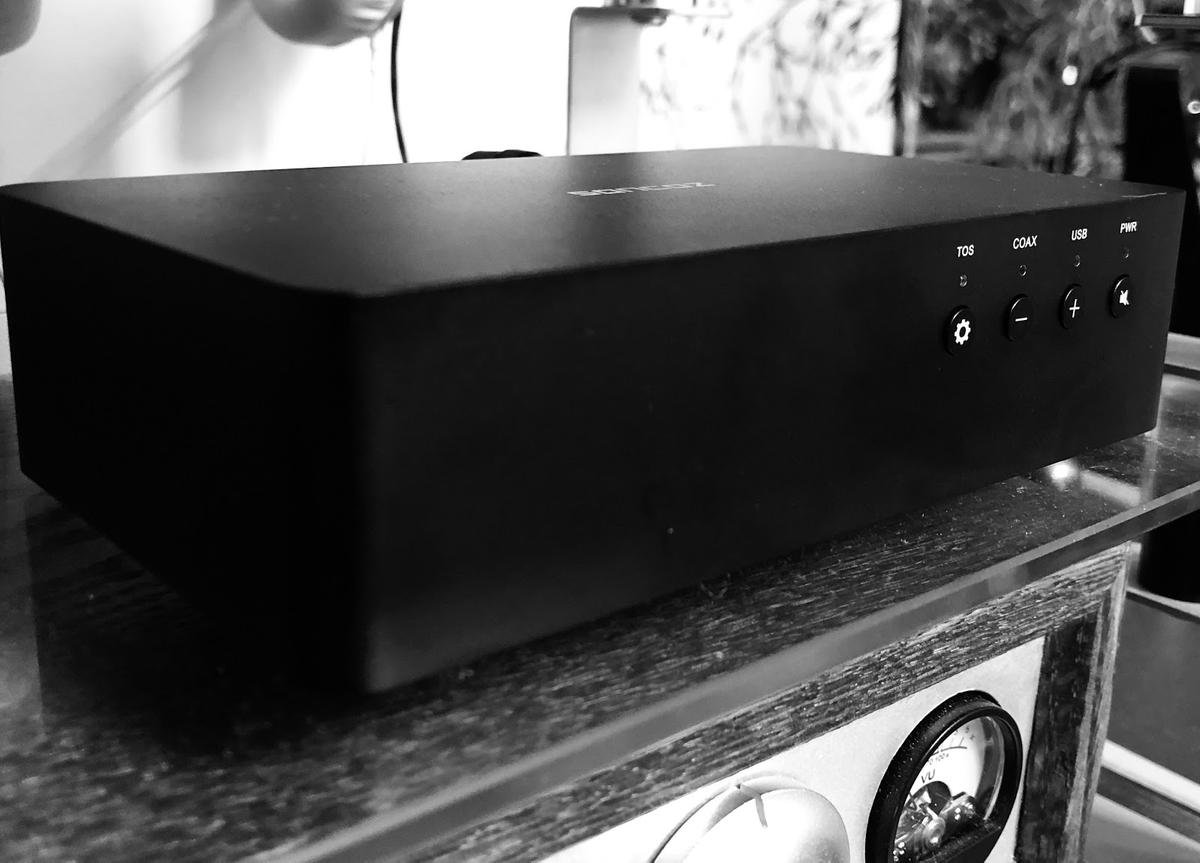
As far as sound quality goes, could you discern it from the Khadas Tone Board?